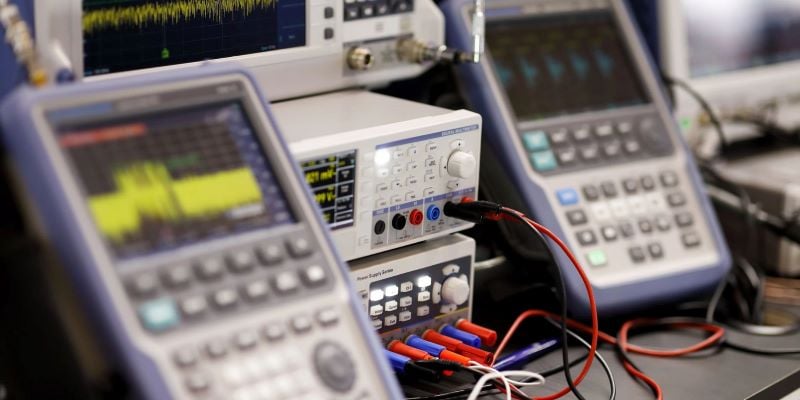Electronic Calibration Essentials: Standards, Processes, and Best Practices

In today's technologically advanced world, electronic instruments are the bedrock of innovation, quality control, and critical operations across countless industries. From designing the next generation of wireless communication to ensuring the reliability of medical devices, the accuracy of these sophisticated tools is paramount. Electronic calibration is the specialized process that guarantees your electronic test and measurement equipment performs precisely as intended, delivering data you can trust.
This blog explores the essentials of electronic calibration, its critical importance for complex measurements, the types of instruments involved, key processes, and the standards that underpin measurement confidence.
What is Electronic Calibration? (And How it Relates to Electrical Calibration)
Electronic calibration focuses on verifying and adjusting the performance of instruments that measure or generate electronic signals, often involving active components, complex signal processing, higher frequencies, or very precise measurements. Think oscilloscopes, spectrum analyzers, and signal generators.
While it builds upon the principles of electrical calibration—which is the broader field concerned with ensuring the accuracy of instruments measuring fundamental electrical quantities like voltage, current, and resistance—electronic calibration often deals with more dynamic and complex parameters specific to electronic devices and systems. Essentially, all electronic calibration involves precise electrical measurements, but it extends to the unique functional characteristics of electronic test equipment.
Why Precise Electronic Calibration is Essential for Innovation and Reliability
In the realm of electronics, precision is not a luxury; it's a necessity. Precise electronic calibration is essential because it directly ensures accurate design validation, confirming that prototypes meet demanding specifications, which in turn underpins reliable research and development (R&D) results, allowing for true scientific advancement. This precision then carries through to manufacturing, where it guarantees consistent manufacturing quality for electronic products, reducing defects and improving yields. Furthermore, calibration enables accurate performance verification of complex electronic systems, such as communication networks or avionics. Finally, it is critical for meeting stringent industry standards and regulatory requirements in sectors like aerospace, defense, and medical technology. Without meticulous calibration, the integrity of your designs, products, and data is fundamentally at risk.
Key Instruments Requiring Electronic Calibration
A wide array of sophisticated electronic test and measurement instruments demand regular, high-precision calibration. These are tools where accuracy directly impacts innovation and product performance:
- Oscilloscopes (calibrating bandwidth, vertical accuracy, timebase accuracy, triggering)
- Spectrum Analyzers and Signal Analyzers (frequency accuracy, amplitude accuracy, phase noise)
- Signal Generators and Function Generators (frequency, level, modulation accuracy, signal purity)
- Network Analyzers (S-parameters, impedance, phase)
- Logic Analyzers and Protocol Analyzers
- High-Precision Digital Multimeters (DMMs) and Source Measure Units (SMUs)
- Power Supplies (voltage/current accuracy, stability, ripple)
- RF Power Meters and Sensors
- Frequency Counters
Understanding the Electronic Calibration Process: Ensuring Peak Performance
The electronic calibration process involves meticulous comparison against even more precise electronic standards and calibrators, often in a controlled lab environment. It goes beyond simple DC or low-frequency checks, frequently involving verification of numerous functions and parameters specific to the instrument. For example, calibrating an oscilloscope might involve checking its rise time and bandwidth, while a signal generator would be assessed for its signal purity and modulation accuracy.
The general steps include rigorous "As Found" tests to determine current performance. Based on these results, adjustments are made; these can be complex, sometimes involving proprietary software or firmware corrections specific to the instrument. Following any adjustments, thorough "As Left" tests are performed to confirm adherence to specifications. A detailed calibration certificate then documents all findings, including traceability information and calculated measurement uncertainties, providing a comprehensive record of the instrument's calibrated state.

Core Electrical Parameters in Electronic Calibration: Beyond Voltage and Current
While electronic calibration addresses the complex functionalities of sophisticated instruments, it fundamentally relies on the precise calibration of core electrical parameters. The accurate measurement or generation of these quantities forms the bedrock of any electronic instrument's performance. These include fundamental Voltage (DC and AC) measurements, often across a wide frequency spectrum from microvolts to kilovolts, and Current (DC and AC), from picoamps to significant levels. Measurements of Resistance, Capacitance, and Inductance (LCR) are vital for characterizing components and circuits. Precision in Frequency and Time is absolutely critical for instruments like oscilloscopes, signal generators, frequency counters, and communication systems, affecting aspects like timing accuracy and jitter. Moreover, Power (DC and RF/Microwave), Phase, and specialized RF/microwave parameters such as S-parameters, attenuation, noise figure, and signal-to-noise ratio are also key areas addressed in comprehensive electronic calibration to ensure overall instrument integrity.
The Role of Standards: ISO/IEC 17025 and NIST Traceability in Electronics
For electronic calibration, adherence to international standards is paramount for ensuring trust, comparability, and global acceptance of measurement results. NIST Traceability (or traceability to another National Metrology Institute) confirms that the calibration of an instrument is linked through an unbroken chain of comparisons to authoritative national or international standards for fundamental electrical and RF quantities. This provides objective, documented evidence of measurement accuracy.
Furthermore, ISO/IEC 17025 Accreditation is the global benchmark for the technical competence of calibration laboratories. Choosing a lab accredited to this standard for electronic calibration means their methods, equipment, personnel expertise, and quality management system have been rigorously audited and verified by an independent body. This accreditation is crucial for industries requiring documented proof of calibration quality, reliability, and the laboratory's ability to produce technically valid results with known uncertainties.
Determining Your Electronic Equipment Calibration Frequency
The optimal calibration interval for electronic equipment is best determined by a dynamic, risk-based assessment rather than a rigid, fixed rule, as no single frequency fits all instruments or applications. Key factors influencing this decision include the specific instrument type and its known stability characteristics; high-frequency RF equipment, for instance, may require more frequent checks than a highly stable DC voltage standard. Always consider the manufacturer's recommendations as a starting point. The criticality of the measurements performed with the instrument and the potential impact of inaccuracies are paramount. The usage environment—including temperature fluctuations, vibration, and potential for electrostatic discharge—can also affect an instrument's performance over time. An instrument's own performance history and any observed drift patterns are invaluable inputs, as are the specific regulatory or quality system requirements pertinent to your industry (e.g., for aerospace, medical, or telecommunications). A proactive approach to scheduling calibration, based on these factors, minimizes risks and ensures ongoing measurement confidence.
How to Choose a Specialist Electronic Calibration Provider
Selecting the right provider for your sophisticated electronic calibration needs is vital. Consider these key factors:
- ISO/IEC 17025 Accreditation: Verify that their scope of accreditation specifically covers the electronic instruments and the precise parameters (including frequency ranges and uncertainties) you need calibrated.
- Technical Expertise: Do they have demonstrable expertise with complex electronic test equipment, including RF/microwave instruments, high-speed digital devices, etc.?
- Low Measurement Uncertainties: For high-performance electronic instruments, the calibration provider must be able to achieve uncertainties significantly better than your instrument's specifications.
- Multi-Brand Capabilities: If you have equipment from various manufacturers, a provider with broad multi-brand expertise can simplify your calibration program.
- OEM Expertise: For instruments like those from Tektronix or Keithley, an OEM or OEM-authorized provider can often offer deeper diagnostic capabilities, firmware updates, and adjustments.
- Turnaround Time (TAT) and overall service quality, including clear communication and comprehensive documentation.
Tektronix: Your Partner for Expert Electronic & Electrical Calibration
Tektronix is a world leader in electronic test and measurement, and that expertise extends directly to our ISO/IEC 17025 accredited calibration services. We provide precise, traceable calibration for a vast array of electronic and electrical instruments, ensuring your equipment delivers the performance and reliability you depend on.
As the Original Equipment Manufacturer (OEM) for Tektronix and Keithley instruments, we offer unparalleled knowledge, proprietary adjustment procedures, and access to firmware updates that ensure your specific equipment is restored to peak factory performance. Our capabilities also extend to multi-brand calibration, covering a wide range of instruments from other leading manufacturers. Whether you need service for oscilloscopes, spectrum analyzers, signal sources, or precision DMMs, Tektronix delivers with expert technicians and state-of-the-art facilities.
Ready to ensure the integrity of your most critical electronic measurements?
Contact Tektronix today to discuss your electronic and electrical calibration requirements or to request a multi-brand quote.


